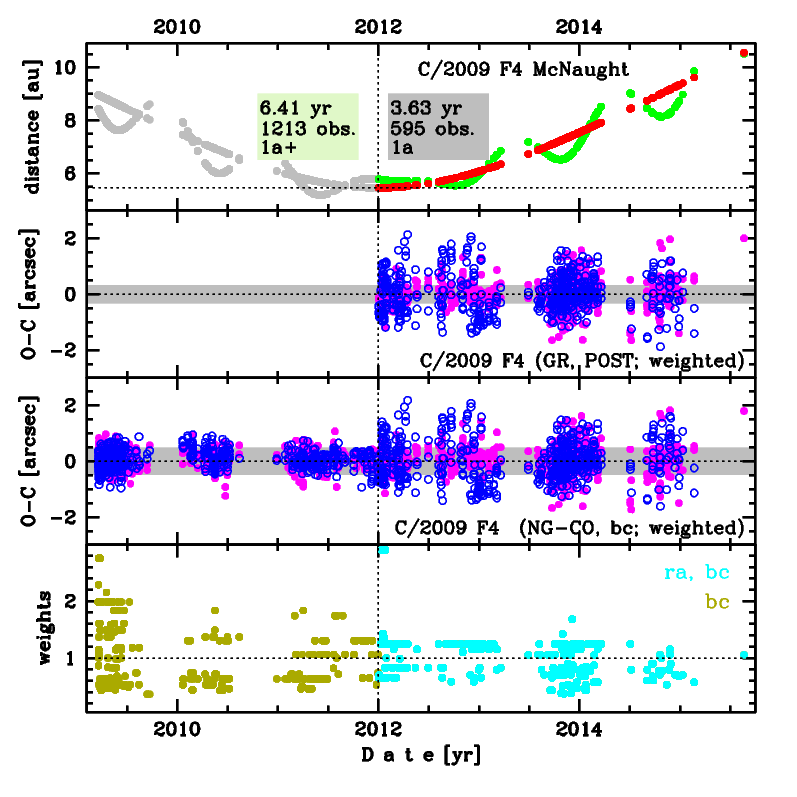C/2009 F4 McNaught
more info
Comet C/2009 F4 was discovered on 19 March 2009, that is 2.8 yr before perihelion passage, and next was observed 6.4 yr during seven oppositions in a range of heliocentric distances: 8.96 au – 5.455 au (perihelion) – 10.5 au.
Comet had its closest approach to the Earth on 3 June 2011 (5.179 au, almost seven months before perihelion).
NG orbits using full data-arc as well as using pre-perihelion data arc are determinable.
This Oort spike comet suffers a tiny planetary perturbations during its passage through the planetary system that lead to a more tight future orbit (see future barycentric orbit).
See also Królikowska and Dones 2023 and Królikowska and Dybczyński 2017.
Comet had its closest approach to the Earth on 3 June 2011 (5.179 au, almost seven months before perihelion).
NG orbits using full data-arc as well as using pre-perihelion data arc are determinable.
This Oort spike comet suffers a tiny planetary perturbations during its passage through the planetary system that lead to a more tight future orbit (see future barycentric orbit).
See also Królikowska and Dones 2023 and Królikowska and Dybczyński 2017.
| solution description | ||
|---|---|---|
| number of observations | 595 | |
| data interval | 2012 01 01 – 2015 08 20 | |
| data arc selection | data generally limited to post-perihelion (POS) | |
| range of heliocentric distances | 5.46 au – 10.55au | |
| detectability of NG effects in the comet's motion | comet with determinable NG~orbit | |
| type of model of motion | GR - gravitational orbit | |
| data weighting | YES | |
| number of residuals | 1158 | |
| RMS [arcseconds] | 0.60 | |
| orbit quality class | 1a+ | |
| orbital elements (heliocentric ecliptic J2000) | ||
|---|---|---|
| Epoch | 2011 12 25 | |
| perihelion date | 2011 12 31.87851654 | ± 0.00106299 |
| perihelion distance [au] | 5.45478680 | ± 0.00000650 |
| eccentricity | 1.00152768 | ± 0.00000480 |
| argument of perihelion [°] | 260.382040 | ± 0.000116 |
| ascending node [°] | 53.584552 | ± 0.000015 |
| inclination [°] | 79.347537 | ± 0.000012 |
| reciprocal semi-major axis [10-6 au-1] | -280.06 | ± 0.88 |

Upper panel: Time distribution of positional observations with corresponding heliocentric (red curve) and geocentric (green curve) distance at which they were taken. The horizontal dotted line shows the perihelion distance for a given comet whereas vertical dotted line — the moment of perihelion passage.
Middle panel(s): O-C diagram for a given solution (sometimes in comparison to another solution available in CODE), where residuals in right ascension are shown using magenta dots and in declination by blue open circles.
Lowest panel: Relative weights for a given data set(s).
Middle panel(s): O-C diagram for a given solution (sometimes in comparison to another solution available in CODE), where residuals in right ascension are shown using magenta dots and in declination by blue open circles.
Lowest panel: Relative weights for a given data set(s).